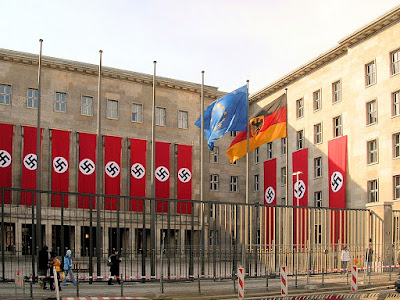Whenever I'm in Berlin, I try to capture some of the history of the place. Much of it I have described in blogs and other posts. Last but not least, my History of Freiburg in Quotes is also a source of information about the events in the Third Reich, particularly in Berlin.
I was met by several younger people and our guide, Jörg. He spoke English with an American accent, so I asked, "Jörg is not an American name." He replied, "I am German but went to high school in the US." That's indeed the best way to learn to speak American English without an accent.
Our group walked toward the Reichstag, where Jörg gave a lengthy introduction to the history of the building. I wrote a picture report about that earlier.

|
|
On June 9, 1881. Note Otto von Bismarck in a white uniform
watching the Kaiser swinging the little hammer. |
We continued to the Russian War Memorial on the Straße des 17. Juni (Street of June 17). On those grounds, 2000 Russian soldiers are buried who died Heroic Deaths during the storming of the Reichstag. Although it had burned out during the Reichstag fire and never served the Nazis as a meeting place, Stalin regarded the building as the symbol of National Socialism and ordered it to be taken as quickly as possible.

|
| A Russian soldier raises the hammer and sickle flag on the ruins of the Reichstag building. |
Ironically, the Reichstag's last "German" defenders were men of the 33rd Waffen Grenadier Division of the SS "Charlemagne" from Alsace.
We then walked past the Brandenburg Gate to the Holocaust Memorial.
I visited the Memorial on the way to
a bike tour in 2005
during a stopover in Berlin.
Further, we went toward Wilhelmstraße and passed a parking lot. Here Jörg stopped and explained to us that at this spot in the courtyard of the Reichskanzlei (Reich Chancellery) near the entrance to the Führerbunker, SS men tried to burn Hitler's and his wife Eva Braun's bodies that they had previously doused with gasoline.

|
| Führerbunker, Myth, and Historical Testimony (click to enlarge) |
We continued to the street corner Wilhelm-Leipziger Straße. In the Weimar Republic, the Reich Defense Ministry was located on Leipziger Straße 5.
The text reads: In 1933, the newly formed Reichsluftfahrtministerium (Reich Aviation Ministry), headed by Hermann Göring, moved into the building. Göring had the complex demolished in 1935, and a monumental new building designed by Ernst Sagebiel with over 2000 rooms was built on the site.

|
|
The giant Aviation Ministry (©Wikipedia) on a welfare stamp 4+3 Pfennig Winterhilfswerk (winter relief) of 1936 |

|
|
Nowadays: Undestroyed Nazi architecture as a historical film set.
Note the German and European flags in front (©telenickkel/Wikipedia) |
After the war, because of the size of the building, several ministries in the GDR used it as their duty station. It became known as the House of Ministries.
After the fall of the Berlin Wall, the Federal Ministry of Finance moved into
the building, and boy, did they need all the space.
The street corner shown on the stamp was made into a memorial for the people's uprising of June 17, 1953, and named Platz des Volksaufstandes von 1953.
70 years ago, about a million people demonstrated throughout the GDR against higher labor standards, but also against the SED (Sozialistische Einheitspartei Deutschlands = Socialist Unity Party of [East] Germany) and for free elections and more prosperity. One of the protesters' slogans was: "Spitzbart, Bauch und Brille sind nicht des Volkes Wille (Goatee, belly, and glasses are not the will of the people)" referring to Party Leader Walter Ulbricht.

|
| In Berlin on June 17, 1953, near the ruins of the Brandenburg Gate (©dpa) |
Being there on June 10, our group missed the 70th anniversary of the
People's Uprising by seven days.
On June 17, 1953, from a safe distance and the safety of the American sector, protesters and onlookers are watching the action outside the House of Ministries on the corner of Wilhelmstraße and Niederkirchnerstraße. They stand on the debris of the Gestapo (Secret Government Police) headquarters. They were destroyed during the war and later wholly demolished. However, some former torture cells in the basement were opened, made accessible, and now serve as a memorial.
Here our guide Jörg abruptly stopped the tour, for we had way overrun the 90 minutes. Red Baron learned quite a lot.
*









Fascinating post.
ReplyDelete